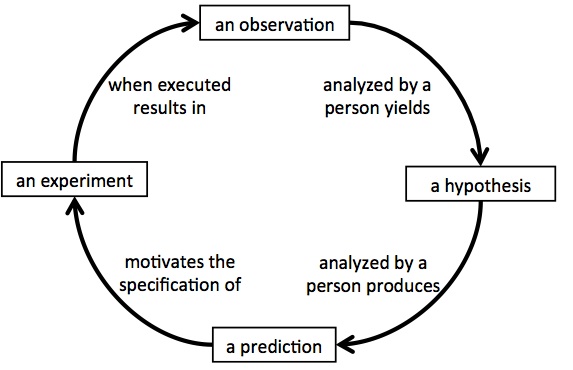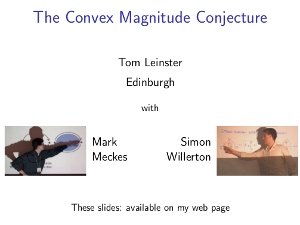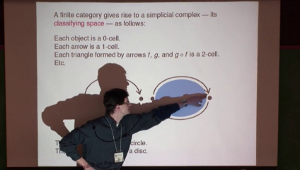March 30, 2013
The Convex Magnitude Conjecture
Posted by Tom Leinster
For a finite subset of , let be the matrix with -entry , and define to be the sum of all entries of .
For a compact subset of , define to be the supremum of over all finite subsets of .
The 2-dimensional case of the convex magnitude conjecture states that for all compact convex ,
I just came back from the British Mathematical Colloquium in Sheffield, where I spoke about the convex magnitude conjecture and attempts to settle it.
Click the picture for slides.
March 27, 2013
Categories for the Working Metaphysician
Posted by David Corfield
This is the great title suggested by my colleague George Darby for the workshop I’m organising, currently going by the name ‘What Can Category Theory Do For Philosophy’? See the website, and follow instructions there if you would like to attend.
I know it clashes with Category Theory 2013, but this was unavoidable. Perhaps we can watch videos from Sydney in the evenings.
March 24, 2013
Project Scheduling and Copresheaves
Posted by Simon Willerton
Obsessed as I am with finding examples of enriched categories, I was struck by the unfamiliar notion of ‘activity network’ when checking a colleague’s course on graph theory. What struck me was how scheduling actives seemed to be like finding a certain kind of copresheaf. Activity networks are also known as PERT charts to people in project management: an activity network or PERT chart records all the dependencies between the activities need to be completed during a project, and also records the times the activities will take to complete. Once you have this information you can try to schedule each of the activities in so that the project is completed as quickly as possible, and you can identify which activities are critical in the sense that any delay in that activity will cause a delay to the whole project.
I noticed that there was some enriched category theory going on with these PERT charts. Patrons of the Café are probably familiar with the idea that metric spaces can be thought of as categories enriched over the category of extended non-negative numbers. The triangle inequality for metric spaces then corresponds to the composition for enriched categories. The category that is enriched over for PERT charts is so the main difference is that the morphisms go the other way, this means that you get a reversed triangle inequality! However, that makes sense in the scheduling context. I will explain how this gives categorical interpretations of terms like earliest start time, latest start time, float and critical path.
I have stressed the project management aspects here, but these ideas are also important, it seems, in scheduling processor jobs in parallel computing.
March 22, 2013
Five Positions at Edinburgh
Posted by Tom Leinster
The School of Mathematics at Edinburgh is advertising five Chancellor’s Fellowships.
We’re interested in people in pretty much all areas of pure and applied mathematics, statistics and operational research. One position is reserved for an algebraist (“Representation Theory, very broadly conceived”).
The positions are five-year fellowships on a reduced teaching load. The idea is that you do mostly research in the first couple of years, and the teaching load is gradually increased until it gets up to the ordinary level by the end of the five years. At that point, if you pass a review, the position converts into a standard “permanent” job. Of course, you shouldn’t take my word for it: the official conditions are on the web.
I’ve now been in Edinburgh for six months, and I highly recommend it: it’s a beautiful city and a great department.
March 21, 2013
Mark on Magnitude
Posted by Tom Leinster
Here’s a truly superb talk by Mark Meckes, on The magnitude of metric spaces.
The talk was at Banff last week, as part of a meeting on The interplay of convex geometry and Banach space theory.
Maybe I was predisposed to like the talk, its subject matter being so close to my heart. But I was awed by how well thought-out it was: it’s just incredibly clear. And he goes from nothing to the cutting edge in under half an hour, without appearing to hurry. If you’re on the internet looking for diversion, look no further!
March 6, 2013
Lectureship in Sheffield
Posted by Simon Willerton
We have a permanent lectureship position in Sheffield associated with the return of Tom Bridgeland after he spent some time in Oxford.
Candidates should possess a strong track record of high quality research in algebraic geometry, very broadly conceived, or any other area linking with Professor Bridgeland’s interests.
For those of you who don’t know him, Tom works in algebraic geometry and its connections with string theory and mirror symmetry, in particular he’s interested in properties of derived categories of coherent sheaves on algebraic varieties. It will be good to have him back in the department!
March 5, 2013
Category Theory in Homotopy Type Theory
Posted by Mike Shulman
Benedikt Ahrens, Chris Kapulkin, and I have just posted the following preprint:
- Univalent categories and the Rezk completion, arXiv:1303.0584
This is mainly a development of basic (1-)category theory using homotopy type theory (a.k.a. “univalent foundations”) as the foundational system. So for all of you readers who’ve been enjoying the posts with vague waffly discussions of type theory, and longing for something to sink your teeth into, this may be a good start.
March 3, 2013
Spivak on Category Theory
Posted by Simon Willerton
Guest post by Bruce Bartlett
We know about Category Theory for Mathematicians, we’ve all read Category Theory for Physicists, and we also know about Category Theory for Computer Scientists, and we’ve even seen the videos.
But how about Category Theory for Scientists? I spotted this on the arXiv listings.
David Spivak, Category Theory for Scientists.
Abstract: There are many books designed to introduce category theory to either a mathematical audience or a computer science audience. In this book, our audience is the broader scientific community. We attempt to show that category theory can be applied throughout the sciences as a framework for modeling phenomena and communicating results. In order to target the scientific audience, this book is example-based rather than proof-based. For example, monoids are framed in terms of agents acting on objects, sheaves are introduced with primary examples coming from geography, and colored operads are discussed in terms of their ability to model self-similarity.

 Posts with this logo use
Posts with this logo use 
















